If you've been hanging around, you've probably seen this facial expression in a photo at least once. Both eyes rolled upwards, tongue stuck out downwards. This facial expression is called ahegao, or ahegao face, and has become very popular in recent years. But since then, its probably racist origin has been at the center of many tensions. Deciphering the ahegao phenomenon that originates from hentai.
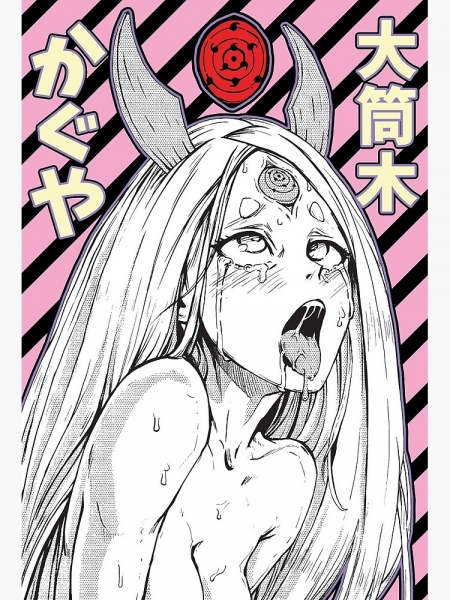
what is ahegao?
The ahegao meme, with the tongue sticking out and the eyes rolling back, has become very popular for a few years now. Several sources agree that even though it dates back much longer, it became trendy in 2008 with the release of a Doujin (Japanese amateur graphic porn) based on ahegao. Since then, many people have taken up the concept, often to ride the trend like the Instagrammer Belle Delphine, who made it her business. Ahegao has also become a symbol of otaku and weeb culture, represented by a series of manga panels (often hentai) printed on various objects, sweatshirts, sweaters or T-shirts.
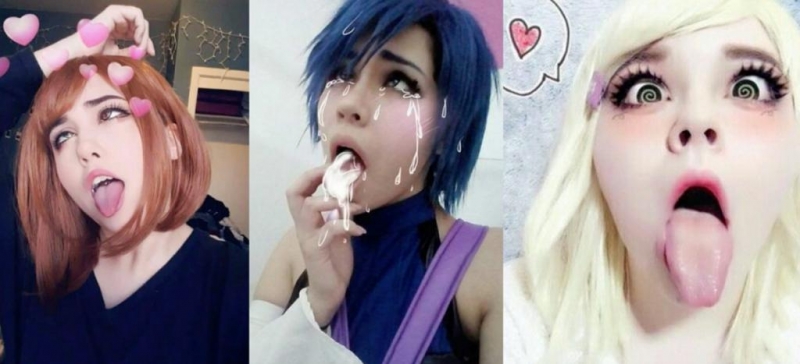
Ahegao in Popular Culture
Often used to denote complete letting go at the moment of reaching orgasm, this expression is also used in other ways, such as sitting, to represent a woman's submission, drooling, tongue out, in front of the object of her desire located above her. Although extremely exaggerated, it is nonetheless more erotic than pornographic, since no sexual organs are shown.
If I had a penny for every person with an ahegao t-shirt that I met today I would have 2 cents, which is not much but it is weird that I have so many
April 1, 2021
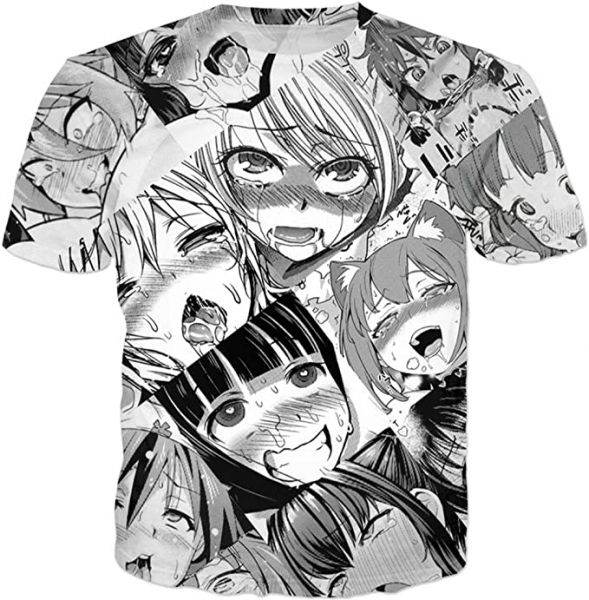
origins of Ahegao
While sources are difficult to obtain and quantify, traces of ahegao can be found as early as the 1980s. Many attribute Japanese artist Suehiro Maruo has been credited with the paternity of ahegao since his erotic horror work “The Girl with the Camellias“, in which traces of Ahegao can be found on a twelve-year-old girl who is sexually abused by her relatives. The artist has often been acclaimed for the accuracy of his style and the harshness with which he describes horror. Even Moebius, a French artist, recognized his talent.
Suehiro Maruo, for his part, draws a lot of inspiration from Yoshitoshi's Muzan-e. A collection of Japanese works, often paintings or woodcuts dating from the end of the Edo and Meiji periods. They depict scenes of absurd torture. They are often presented as the first traces of Ero Guro, or erotic-grotesque movement. A subversive art form that seeks to find eroticism in images of violence and mutilation.
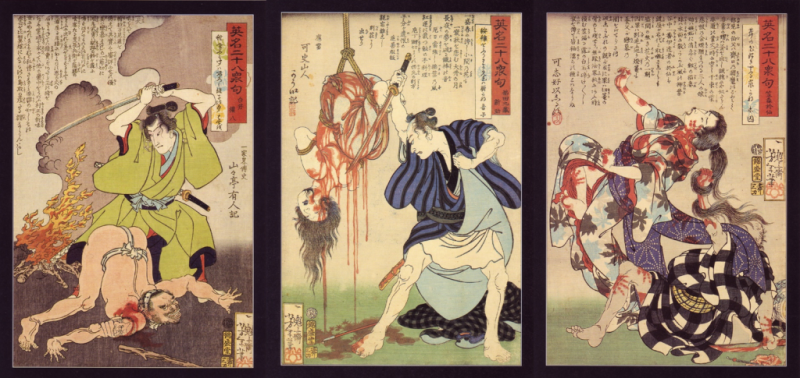
Ahegao: A Problematic Trend?
And that's precisely the problem. For some Internet users, the Ahegao would be an integral part of the culture of rape and fetishism of Asian teenagers. It would be an element of fantasy of the racist West towards Asia. Many young Asian women would find themselves forced to make this face by their partner. Ahegao would reinforce the stereotype of the submissive Asian woman, easily manipulated and who wants/desires punishment or abusive treatment.
Of course, ahegao in itself does not justify aggression against another person. But overconsumption of porn, and therefore hentai is often pointed out. Like any other position, this one must be done with the consent of the spouse. Oh, and a little reminder: porn is not a reflection of reality, it does not hurt.
200% Deposit Bonus up to €3,000 180% First Deposit Bonus up to $20,000The ahegao, a symbol of sexual liberation
If ahegao can be a problematic trend as we have seen above, it can, conversely, sometimes be synonymous with sexual liberation. Indeed, it can be perceived as an act of rebellion against a society that is sometimes too castrating in terms of sexuality. Often criticized for a sexuality that is “too” unbridled, some people see aheago as a way to abolish taboos and to show that their sexuality is not shameful. Aheago is thus often represented in the world of cosplay in order to provoke and transgress certain rules.
The influence of celebrities and personalities on the popularity of Ahegao
The ahegao has also been, if not popularized, then at least relayed by certain personalities, notably from the Internet. We can notably cite Belle Delphine (Mary-Belle Kirschner in real life) who reproduced this gesture from hentai culture on numerous Instagram posts. The TikTok platform, like Instagram, also has many fans of the ahegao who do not hesitate to reproduce this face from hentai to generate likes and comments.
The impact of the ahegao on fashion
Ahegao, after influencing social networks, has logically spread to other areas, including fashion. Thus, in South Korea, we could find an image of the hentai artist Hirame, representing an “ahegao face”, on many fashion accessories: handbags, phone cases, cushions… Clothing lines have also appeared, using the same ahegao symbol on t-shirts or sweatshirts. Closer to home, we can cite representations of the hentai Danke Dankei Revolution, seen on clothes sold in Europe. Conversely, the United States seems to have been less appreciative of this clothing trend since in January 2020, the country banned the wearing of clothing representing ahegao at anime conventions held on American territory.
Ahegao, testimony of a victim of fantasies
We would like to end this article with the testimony of a young Asian Internet user, victim of fantasies around ahegao.
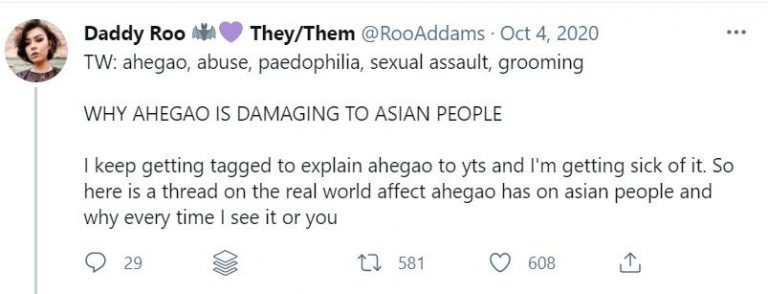
TW (trigger Warning): Ahegao, abuse, pedophilia, rape, pedo-trapping
WHY AHEGAO HURTS ASIAN PEOPLE
I keep getting mentioned to explain ahegao and it makes me sick. So here is a thread of how ahegao affects Asian people in the real world and why every time I see it it triggers my trauma.
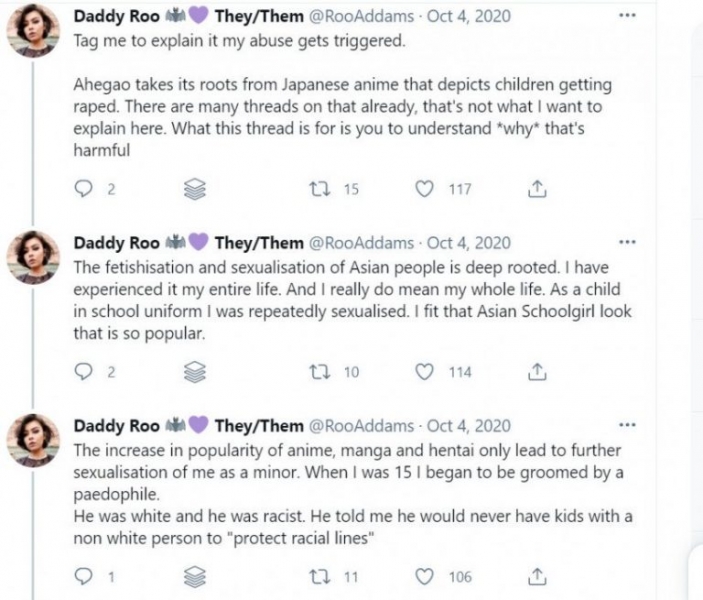
Ahegao has its roots in a Japanese anime that depicts a child being raped. There are already plenty of threads on this, that's not what I want to talk about today. This thread is so you can understand why it's harmful.
The fetishization and sexualization of Asian people is deeply ingrained. I've experienced it my entire life. As a child in school uniform, I was constantly sexualized. I fit the popular stereotype of the Asian schoolgirl.
The rise in popularity of anime, manga, and hentai has only made this problem worse for me as a minor. When I turned 15, I started being groomed by a man. He was white and racist. He told me he would never want non-white children to protect the race.
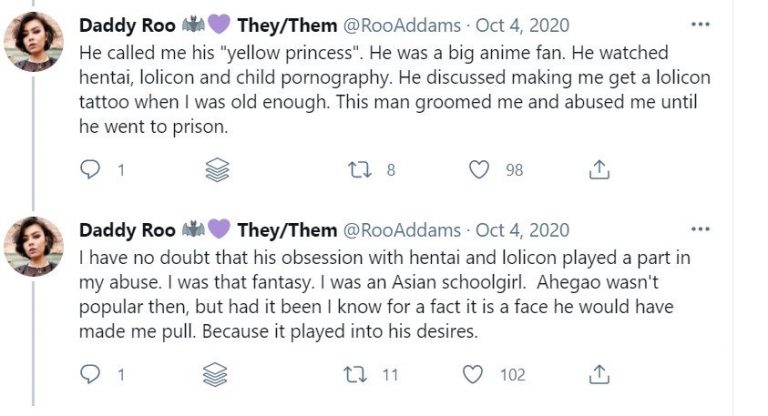
He called me his “yellow princess”. He was a huge fan of anime, hentai, lolicon, and child pornography. He had spoken to me about his desire to give me a lolicon tattoo when I was old enough. This man child molested and abused me until he went to prison.
I have no doubt that his obsession with hentai and lolicon played a large role in this sexual abuse. I was his vision of an Asian schoolgirl. Ahegao wasn't popular at the time, but I knew that was the face he wanted me to make. Because it played on his desire.
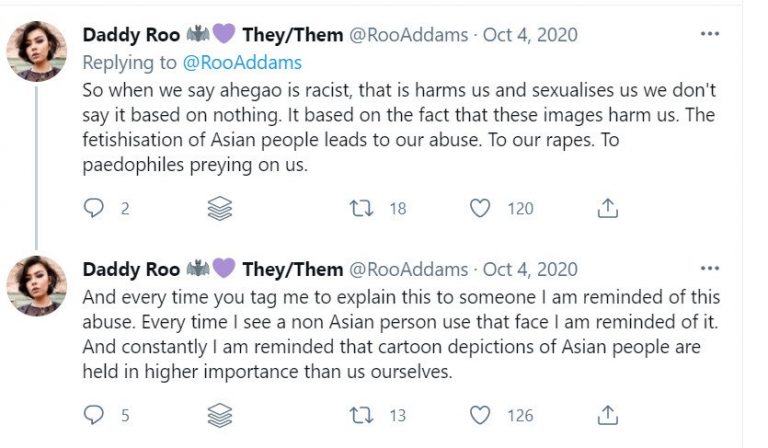
So when we say that ahegao is racist, that it hurts us and sexualizes us, it is not based on nothing at all. It is based on facts and this vision hurts us. The fetishization of Asian people leads to our sexual abuse. To our rape. To pedophiles preying on us.
And every time you mention me to explain this to someone, I'm reminded of that abuse. Every time I see a non-Asian person make that face, I'm reminded of it. And I'm constantly reminded that cartoon depictions of Asian people are more important than we are

